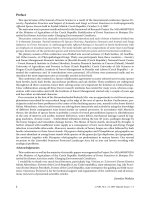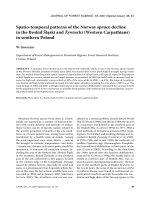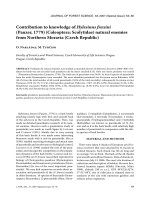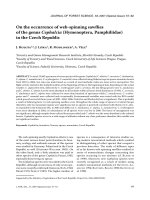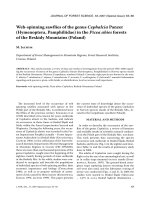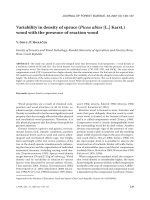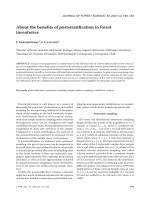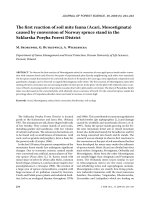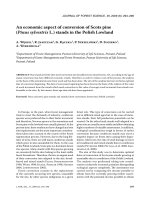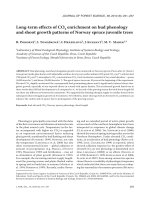Báo cáo lâm nghiệp: "Stable Agrobacterium-mediated transformation of Norway spruce embryogenic tissues using somatic embryo explants" ppt
Bạn đang xem bản rút gọn của tài liệu. Xem và tải ngay bản đầy đủ của tài liệu tại đây (900.99 KB, 4 trang )
J. FOR. SCI., 57, 2011 (7): 277–280 277
Stable Agrobacterium-mediated transformation of Norway
spruce embryogenic tissues using somatic embryo explants
D. P, J. B, H. N, J. V
Institute of Plant Molecular Biology, Biology Centre of the Academy of Sciences
of the Czech Republic, České Budějovice, Czech Republic
ABSTRACT: In conifers and other plants with long reproductive cycles, transformed embryogenic tissues can serve
as a convenient source of plant material for the testing of insecticidal or fungicidal transgene efficiency. In this report,
transgenic embryogenic tissue was obtained after the transformation of somatic embryos of Norway spruce (Picea abies
(L.) Karst.) by Agrobacterium tumefaciens with the gus-intron chimeric gene. The stable integration of transgenes was
confirmed by PCR and Southern hybridization. The transformation was successful only in a suitable embryogenic cell
line sensitive to Agrobacterium. Out of the nine embryogenic lines tested only one gave transgenic callus.
Keywords: Agrobacterium tumefaciens; genetic engineering; GUS activity; Picea abies (L.) Karst.
Supported by the Ministry of Agriculture of the Czech Republic, Project No. QH71290, and by the CEZ, Projects No.
AV0Z50510513 and No. FP7-REGPOT-2008-1-229518.
Conventional plant breeding methods have re-
sulted in significant genetic gains in some conifers
(S et al. 1989). e long reproductive
cycles of conifers, however, render conventional
breeding techniques highly time consuming, and
some desirable traits of commercial value, such as
insect and fungal resistance, are not available in
the breeding populations. e genetic engineering
methods and tissue culture technologies offer faster
and more efficient introduction of desired attributes.
Genetic transformation of plants by Agrobacte-
rium tumefaciens is the preferred method of trans-
gene integration into plant genome. A stable trans-
formation procedure has been developed also for
various forest tree species (e.g. B 2000); the first
transgenic tree was described in 1987 (F et
al. 1987). Transgenic conifers were reported about
15 years ago (H et al. 1991) and to date there
have been only a few reports of stably transformed
conifers using Agrobacterium (e.g. K-
et al. 2003; C et al. 2005; H,
W 2006).
e Norway spruce (Picea abies [L.] Karst.) is
an important source of timber in Central Europe.
Nevertheless, the damage caused by bark beetles
(Scolytidae) entails significant economic losses. e
production of transgenic trees with increased in-
sect resistance is one of the possibilities which can
solve this problem. However, the effective method
of genetic transformation of spruce is necessary.
K et al. (2001) obtained transgenic
spruce plants after the co-cultivation of embryo-
genic tissues with Agrobacterium tumefaciens. e
possibility of Agrobacterium-mediated transforma-
tion of spruce embryogenic tissues was described
also by W et al. (1999) and L et al. (2001); non-
embryonic tissues do not usually have a sufficient
regeneration capacity for transgenic plant regen-
eration. Particle bombardment is another method
how to obtain transgenic spruce. One may use either
embryogenic masses (E et al. 1993; C et
al. 1996; T et al. 2000) or somatic embryos (R-
et al. 1992; B et al. 1993) as bi-
olistic target.
In this paper we report a novel method of genetic
transformation of spruce, namely the Agrobacte-
rium tumefaciens-mediated transformation of cot-
yledonary somatic embryos.
JOURNAL OF FOREST SCIENCE, 57, 2011 (7): 277–280
278 J. FOR. SCI., 57, 2011 (7): 277–280
MATERIAL AND METHODS
Plant material and transformation procedure
e embryogenic cell lines of Norway spruce
(Picea abies [L.] Karst.) were obtained from For-
estry and Game Management Research Institute,
Strnady, Czech Republic (M 1991; M et al.
1995). Embryogenic tissues were maintained in the
dark and at 23°C on half-strength Litvay medium
including vitamins (Duchefa) (L et al. 1985)
containing 400 mg·l
–1
-glutamine and 400 mg·l
–1
casein hydrolysate (L1 medium), supplemented
with 2.2mM BAP, 4.5mM 2,4-D, 2.3mM kinetin,
2mg·l
–1
glycine, 20 g·l
–1
sucrose and 2 g·l
–1
gelrite
(L2 medium).
Not fully developed cotyledonary-stage somatic
embryos were collected 4–6 weeks after the trans-
fer of embryogenic tissues to L1 medium supple-
mented with 50mM ABA, 6% sucrose and 6 g·l
–1
Phytagel
TM
(Sigma) according to T et al. (2000).
e transformation of somatic embryos of Nor-
way spruce was carried out by Agrobacterium tu-
mefaciens strain LBA4404 containing the helper
plasmid pAL4404 and binary vector with the gus-
intron chimeric gene and nptII selectable gene
(V et al. 1990). An overnight liquid
culture of A. tumefaciens was pelleted by centrifu-
gation, resuspended in 10mM MgSO
4
to an optical
density of OD
600 nm
0.9 and a sterile solution of ace-
tosyringone was added to a final concentration of
50mM. e somatic embryos were cultivated in this
solution for 45 min at 23°C on a shaker (100rpm)
and then they were transferred onto L2 medium.
After 48 hours, the somatic embryos were placed
onto L2 medium supplemented with 400 mg·l
–1
Timentin. Reinduced embryogenic tissues were
carried onto L2 medium supplemented with
200mg·l
–1
cefotaxime and 25 mg·l
–1
kanamycin.
Detection of gusA and nptII genes in transgenic
embryogenic tissues
Kanamycin-resistant embryogenic tissues were
screened for the presence of gusA gene by poly-
merase chain reaction (PCR). e DNA samples for
PCR were prepared with Extract-N-Amp
TM
Plant
PCR Kit (Sigma). e primers GUS1 5'-TCGAT-
GCGGTCACTCATTAC-3' and GUS2 5'-CCACG-
GTGATATCGTCCAC-3' which amplify a 495 bp
fragment were used. is fragment consists of a
part of the gusA gene including an intron in nu-
cleotide position 263–757. e samples were
heated to 94°C for 4 min, followed by 35 cycles of
94°C for 45 s, 55°C for 30 s, 72°C for 2 min, with
a final extension step of 72°C for 10 min. e ab-
sence of residual bacterial contaminants was dem-
onstrated in all tested embryogenic tissues by PCR
using primers for virA gene, located outside of the
T-DNA. e primer sequences used 5'-AATTC-
ACCGACGCGGCAGGATTTTAAGACAG-3' and
5'-AGCTTTGGTACGAGAGACTATTTCGCG-
TAG-3' amplified DNA fragment of 1093 bp.
Southern blot analysis
Genomic DNA for Southern blot analysis was
extracted from kanamycin resistant embryogenic
tissues as described by T and T (1991).
About 15 mg of DNA were digested with HindIII
restriction enzyme, resolved overnight in 1% aga-
rose gel with TBE buffer (S et al. 1989)
and transferred onto nylon Hybond-N membrane.
Southern hybridizations were performed accord-
ing to C and G (1984). e mem-
brane was probed with the 699 bp fragment of the
nptII gene. e probe was labelled with [a-
32
P]
dCTP (3,000 Ci·mmol
–1
) using a random priming
kit, Rediprime
TM
II, and membranes were autoradi-
ographed for 5 h using a phosphorimager Typhoon
system (Amersham Pharmacia Biotech).
GUS assay
GUS activity was determined using a histochem-
ical assay with X-gluc as substrate (J
1987).
RESULTS AND DISCUSSION
We report a procedure for the testing of Picea
abies embryonic tissue susceptibility to Agro-
bacterium tumefaciens and for the production of
transgenic embryogenic tissues from transformed
somatic embryos. Using the gus gene transient ex-
pression assays followed by selection of kanamy-
cin resistant tissues we could confirm the finding
of K et al. (2001) that the success
of spruce embryogenic tissue transformation is
dependent on the choice of embryogenic cell line
sensitive to Agrobacterium. Starting with embryos
developed from nine embryogenic cell lines we
found that seven lines never responded to Agro-
bacterium, showing neither transient expression in
embryos nor growth of kanamycin resistant tissue.
J. FOR. SCI., 57, 2011 (7): 277–280 279
Two lines only (S10 and S13) showed the transient
expression of gusA gene (Fig. 1). Two independent
experiments were performed and some variability
in transient expression was also recorded. Still, the
transient expression of a marker gene closely linked
to a selectable gene facilitates the identification of
Agrobacterium-responsive embryonic lines.
We verified in previous experiments that a sufficient
concentration of kanamycin for the selection of spruce
transformed embryogenic tissues is 25 mg·l
–1
(M
et al. 2009) and that the Timentin concentration of
400mg·l
–1
followed by cefotaxime 200 mg·l
–1
reliably
kills Agrobacterium in the course of a few months. e
absence of bacteria was confirmed by PCR.
To apply more stringent selection and to avoid
toxic effects of dying non-transformed cells on
transgenic embryo viability (M et al.
2003), the transformed embryos were transferred
to a dedifferentiating medium and embryogenic
tissues were obtained that were further selected on
kanamycin and then reinduced. e screening of
reinduced embryogenic tissues growing on a me-
dium with kanamycin 25 mg·l
–1
affirmed the pres-
ence of gusA gene in many of them (Fig. 2).
e growth of reinduced embryogenic tissues
was initially very slow, as probably only a small part
of cells was transformed. e heterogeneity of ob-
tained tissues during the first six months of growth
was also confirmed by PCR; the samples taken from
various places of one embryogenic tissue showed
different results.
Based on PCR assays 27 positive tissues were cho-
sen and cultivated gradually on 50, 75 and 100mg·l
–1
kanamycin. A stronger selective pressure was used
to eliminate nontransgenic cells in embryogenic
tissues. e best growing tissue on a medium with
100 mg·l
–1
kanamycin that was obtained from the
S10 line embryo transformation was selected and
the stable integration of the transgene was proved
there by Southern blot analysis (Fig. 3).
Fig. 1. e transient expression of gusA gene in transformed
somatic embryos of S10 line. Blue sectors correspond to the
GUS activity
Fig. 2. An example of PCR analyses for the detection of 495bp
fragment of gusA gene in transformed embryogenic tissue
Fig. 3. Southern hybridization analysis of
HindIII-digested DNA from transformed
embryogenic tissue of spruce. DNAs were
hybridized with 699 bp nptII probe
lane 1 – transformed embryogenic tissue,
lane 2 – non-transformed control
1
M
kbp
2
2
3
4
5
6
8
10
1.6
kbp
1 65
4
32 987
10
19181716
1514
13
12
11
2423222120 28272625
30
29
1.6
1.6
1.6
1.6
M
M
Southern hybridization using the nptII gene de-
rived probe and HindIII digested genomic DNA al-
lowed us to estimate the number of inserted copies
of T-DNA. e fragment size of 1.4 kb at least was
expected for transgenic tissue. Fig. 1 documents
that the transgenic callus harboured a single copy
of T-DNA.
References
B Y.P.S. (2000): Transgenic Trees. Berlin, Heidelberg,
New York, Barcelona, Hong Kong, London, Milan, Paris,
Singapore, Tokyo, Springer.
B V.R., C R.N., D R.S.S., T
E.W.T. (1993): Transformation of white spruce (Picea
glauca) somatic embryos by microprojectile bombardment.
Plant Cell Reports, 13: 17–23.
280 J. FOR. SCI., 57, 2011 (7): 277–280
C J.A., H L., G L.J., W C. (2005):
Consistent and stable expression of the nptII, uidA, and
bar genes in transgenic Pinus radiata after Agrobacterium
tumefaciens-mediated transformation using nurse cultures.
Plant Cell Reports, 23: 606–616.
C P.J., D Y., L D. (1996): Stable
genetic transformation of Picea mariana (black spruce) via
particle bombardment. In Vitro Cellular & Developmental
Biology – Plant, 32: 91–99.
C G.M., G W. (1984): Genomic sequencing.
Proceedings of the National Academy of Sciences of the
United States of America, 81: 1991–1995.
E D.D., MC D.E., MI S., R
R., R D.R., W K.M., M B.J.,
R D.R., R K.F., MC B.H. (1993): Stable
transformation of Picea-glauca by particle-acceleration.
Bio-Technology, 11: 84–89.
F J.J., S J., MC B., H B., C
L. (1987): Agrobacterium mediated transformation and
regeneration of Populus. Molecular and General Genetics,
206: 192–199.
H A.R., W C. (2006): Genetic engineering in
conifer plantation forestry. Silvae Genetica, 55: 253–262.
H Y., D A.M., K D.F. (1991): Agrobac-
terium rhizogenes-mediated genetic transformation and
regeneration of a conifer: Larix decidua. In Vitro Cell and
Developmental Biology, 27: 201–207.
J R.A. (1987): Assaying chimeric genes in plants:
the GUS gene fusion system. Plant Molecular Biology
Reporter, 5: 387–405.
K K., L D., P G., L M A.,
S A. (2001): Regeneration of transgenic Picea glauca,
P. mariana and P. abies after cocultivation of embryogenic
tissues with Agrobacterium tumefaciens. In Vitro Cellular
& Developmental Biology – Plant, 37: 748–755.
K K., L D., B-C M.,
R R.G. (2003): Transgene integration patterns
and expression levels in tarnsgenic tissue lines of Picea
mariana, P. glauca and P. abies. Plant Cell Reports, 21:
1080–1087.
L V.Q., B-I J., D M., T
F.M. (2001): An improved procedure for production of
white spruce (Picea glauca) transgenic plants using Agro-
bacterium tumefaciens. Journal of Experimental Botany,
52: 2089–2095.
L B.I., V D.C., J M.A. (1985): Culture
medium and its components on growth and somatic em-
bryogenesis of the wild carrot (Daucus carota L.). Plant
Cell Reports, 4: 325–328.
M J. (1991): Organogenesis and somatic embryogenesis
in spruce. Communicationes Instituti Forestalis Cecho-
slovaca, 17: 16–23.
M J., D M., K J. (1995): e development
of encapsulated somatic embryous of Norway spruce (Picea
abies (L.) Karst.). Communicationes Instituti Forestalis
Bohemicae, 18: 59–73.
M J., P D., C H., B J., D
J., Š P. (2009): Norway spruce (Picea abies (L.) Karst.)
embryogenic tissue tolerance to penicillin, carbapenem,
and aminoglycoside antibiotics. Journal of Forest Science,
55: 156–161.
M S., L-L D., J S. (2003): Fac-
tor affecting Agrobacterium-mediated transformation of
Picea omorica (Panc.) Purk. somatic embryos. Periodicum
Biologorum, 105: 313–317.
R D., W A.K., A R., G S.,
S R.R. (1992): Genetic-transformation of Norway
spruce (Picea abies (L.) Karst.) using somatic embryo ex-
plants by microprojectile bombardment. Plant Molecular
Biology, 19: 925–935.
S J., F E.F., M T. (1989): Molecular
Cloning: A Laboratory Manual. Cold Spring Harbor Labo-
ratory Press, New York.
S C.J.A., C M.J., W M.D. (1989):
New techniques in the genetic improvement of radiata
pine. Commonwealth Forest Review, 68: 3.
T T., T S. (1991): A rapid and inexpensive method
for isolation of total DNA from dehydrated plant tissue.
Plant Molecular Biology Reporter, 8: 297–303.
T L N., C P.J., S A., R R.G. (2000):
Hygromycin resistance is an effective selectable marker for
biolistic transformation of black spruce (Picea mariana).
Plant Cell Reports, 19: 358–362.
V G., S R., O’C-S L.,
W L., R-S M. (1990): Construction of
an intron-containing marker gene: splicing of the intron in
transgenic plants and its use in monitoring early events in
Agrobacterium-mediated plant transformation. Molecular
and General Genetics, 220: 245–250.
W A.R., Q M., W R.W., P G.,
S R. (1999): High-efficiency Agrobacterium-
mediated transformation of Norway spruce (Picea abies)
and loblolly pine (Pinus taeda). Plant Molecular Biology,
39: 407–416.
Received for publication April 23, 2010
Accepted after corrections April 11, 2011
Corresponding author:
Mgr. D P, CSc., Biology Centre of the Academy of Sciences of the Czech Republic,
Institute of Plant Molecular Biology, Branišovská 31, 370 05 České Budějovice, Czech Republic
e-mail:
